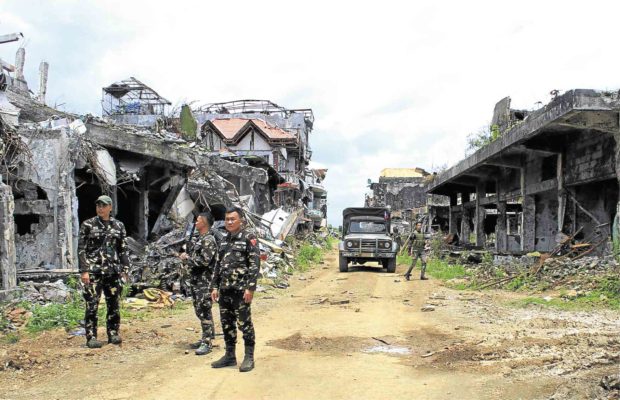ARMM economy surges despite conflict in Marawi

BATTLE ZONE Soldiers inspect a section of Marawi City where members of the Maute terror group and Abu Sayyaf bandits engaged government forces in a five-month battle last year. RICHEL V. UMEL
Despite fighting between government forces and Islamic State supporters that spanned five months in Marawi City, the economy of the Autonomous Region in Muslim Mindanao (ARMM) grew 7.3 percent in 2017 on the back of a recovery in the agriculture sector, the government reported on Thursday.
For the country’s chief economist, the Marawi crisis that started on May 23 last year when members of the Maute and Abu Sayyaf groups laid siege to the city could have also boosted ARMM’s local economy.
Stimulus
“One explanation may be that war expenditures typically serve as growth stimulus to other areas not directly affected by the fighting,” Socioeconomic Planning Secretary Ernesto Pernia told the Inquirer when asked about the jump in ARMM’s gross regional domestic product (GRDP) growth rate last year.
The region’s GRDP expansion last year climbed from the 0.3-percent growth in 2016, which reversed the 0.4-percent contraction in 2015, the latest Philippine Statistics Authority (PSA) data showed.
Article continues after this advertisementIts 2017 growth was outpaced only by the Cordillera’s 12.1 percent, Davao Region’s 10.9 percent, Western Visayas’ 8.4 percent and Soccsksargen’s (South Cotabato, Cotabato, Sultan Kudarat, Sarangani and General Santos City) 8.2 percent.
Article continues after this advertisementLast December, the state planning agency National Economic and Development Authority said martial law declared by President Duterte in Mindanao would not impact on the island’s local economy.
Recovery
In a statement, the PSA mainly attributed the acceleration in ARMM’s economy to “the recovery of the agriculture, hunting, forestry and fishing sector,” which accounted for the biggest chunk, or 56.4 percent, of the region’s economy last year.
In terms of percentage points, the agriculture, hunting, forestry and fishing sector contributed 4.3 percentage points to the region’s 7.3-percent GRDP growth, while services and industry sectors added 2.4 percentage points and 0.6 percentage points, respectively.
The services sector, which composed 37.7 percent of the ARMM’s GRDP, grew by a faster 6.3 percent last year from 5.5 percent in 2016.
Industry, meanwhile, expanded 10.8 percent from 2.5 percent a year ago, to comprise 5.9 percent of the region’s output.
“Mining and quarrying, and electricity, gas and water supply posted a double-digit growth of 31.9 percent and 16.3 percent, respectively. Likewise, manufacturing and construction contributed positively to the growth but at a slower pace of 4 percent and 2.5 percent, respectively,” the PSA added.
‘Big thing’
ARMM Gov. Mujiv Hataman said it remained to be seen if the region’s fast growth trickled down to the people.
“The ARMM is far from perfect, but the reforms we have institutionalized in the region have been crucial. Our sluggish economy in the past was never about a lack of resources but of political will, which is why we have committed ourselves to making the ARMM bureaucracy work better for the people,” Hataman said.
Hataman said being cited as the country’s fifth fastest growing region last year was “already a big thing.”
“People used to say this kind of growth was impossible in the ARMM but through our collective efforts in the regional government, together with our civil society partners, we have made it possible,” Hataman said.
Hataman said the growth indicated that business was good in ARMM because of improved peace and order conditions, despite the Marawi crisis.
Investments
“Despite what happened in Marawi, our economy grew better. The Marawi incident was contained and there had been no major encounters in the region because of the peace process [with the Moro Islamic Liberation Front],” he said.
ARMM’s Regional Board of Investments (RBOI) said capital continued to flow into the region.
“Despite the Marawi crisis, the investment prospects of ARMM continue to show signs of resilience and dynamism because the crisis area has effectively been contained by the government,” said Ishak Mastura, RBOI chief.
PSA data showed that all regions posted year-on-year GRDP growth rates in 2017: Central Luzon, up 9.3 percent; Metro Manila (National Capital Region), 6.1 percent; Northern Mindanao, 5.9 percent; Ilocos, 5.8 percent; Central Visayas, 5.1 percent; Bicol, 5.1 percent; and Zamboanga Peninsula, 2.3 percent.
Eastern Visayas posted the slowest growth rate at 1.8 percent.